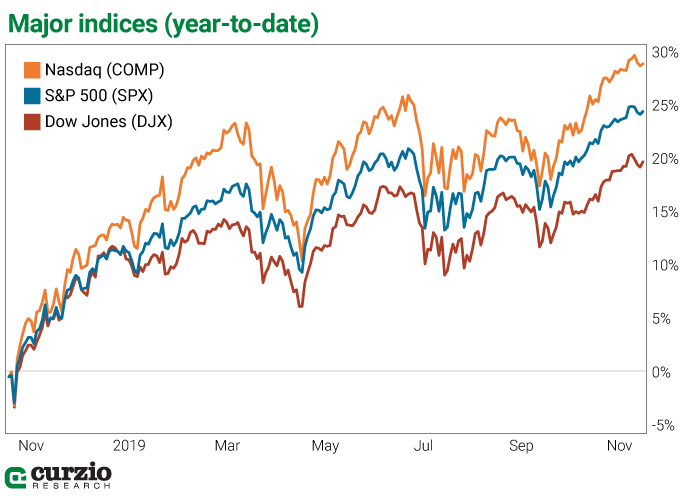Investors have a lot to be thankful for this Thanksgiving…
Unlike last year (when stocks sold off in the fourth quarter), we’re entering the holiday season on a high note.
A few days ago, the Dow Jones Industrial average closed above 28,000 for the first time ever. The S&P 500 and tech-heavy Nasdaq hit records, too. And while the indices have given up some ground since then, they remain on pace for a very strong year.
As of last Friday, the S&P 500 was up 24.1%, the Dow up 19.5%, and the Nasdaq up 28.4% for 2019.

Despite these positive trends, nobody would blame you for wanting to take some gains off the table. Booking some profits keeps them from disappearing should the market direction change.
But if you want to stay invested, you have history on your side. Not only does the market tend to rise over time, we’re entering a historically strong half of the year. The six months from Thanksgiving to May have been, on average, stronger than the May–November period. (The maxim “sell in May and go away” reflects this phenomenon.)
Plus, after three interest rate cuts by the Fed this year, money has become cheaper—another positive for equities.
But here’s the really good news: If you don’t want to give up on potentially higher returns, you have access to a tool that’s proven to reduce your market risk.
It’s something every single investor can and must do.
I’m talking about diversifying.
It’s a scientifically proven risk reduction strategy…
In 1990, economist Harry Markowitz was awarded the Nobel Memorial Prize in Economic Sciences for proving that uncorrelated assets in a portfolio reduce its risk.
(Fun fact: Markowitz was a finance professor at my alma mater, Baruch College of the City University of New York, when he was awarded the prize.)
I know, I know, “correlation” sounds boring. But it simply means that assets will (or won’t) move in the same direction under similar circumstances.
“A rising tide lifts all boats” is an example of positive correlation.
When one asset moves up and the other declines—which is a more or less typical situation for stocks and bonds—that’s negative correlation. (This is why financial planners suggest having both stocks and bonds in one’s portfolio.)
Yet, in real life, it’s hard to find uncorrelated assets. Most stocks move more or less together, and sometimes even stocks and bonds move in the same direction.
But if you’re a rational investor, you need to own a wide variety of positions and assets.
The less correlated your assets are, the less market risk your portfolio will have. And spreading your risks between stocks, bonds, and other assets is the first step in setting up a well-diversified portfolio.
You’ll also want to diversify within those holdings. A portfolio of stocks and bonds from a variety of sectors and industries will reduce your risk should a problem occur within an individual company or befall an entire sector. (You’d still be exposed to market risks, like a recession-related decline, but the less risk the better.)
Another important aspect of diversification is to make sure no single position overwhelms your portfolio.
Investors end up with concentrated stock positions in a variety of ways. They could be holding onto a top-performing stock and expecting more returns… They may have an emotional attachment to the stock and are reluctant to sell… It could be a case of not wanting to sell because of a potential taxable gain… Some may even have accumulated a very large single-stock position as compensation from their employer.
Having a few large holdings could also be damaging if they’re from the same sector or industry. Since returns on such holdings are generally positively correlated, any damage to one would be felt in the other. Your risk is increased.
Remember: Having one large position—regardless of the source—increases your exposure to risks unique to that particular stock or sector.
Another important consideration when diversifying is how many different assets you should hold.
A common answer is 25 to 30, but the number really depends on the diversification of your holdings. A carefully chosen portfolio could hold less. That’s especially true if you own securities other than individual stocks, such as mutual funds or exchange-traded funds (ETFs).
Consider a variety of assets when building your portfolio. Proper diversification includes holding more than just traditional stocks and bonds.
Gold is one example. Its price depends on a totally different set of factors than what moves the stock market. Gold usually doesn’t rise or fall in unison with the price of other financial assets. That’s why investors often turn to gold in times of market volatility.
Bitcoin and other next-generation financial assets, while still very young, also don’t appear to move in the same direction as stocks. And international or emerging markets—like the mired-in-Brexit U.K.—can sometimes offer more value than the U.S.
Then there’s cash… It doesn’t yield much, and doesn’t promise any returns, but it will protect your downside. Just remember that having a cash position doesn’t excuse you from diversifying the rest of your portfolio.
Think of diversification as your first line of defense. By having a healthy combination of stocks, bonds, and alternative assets like gold or bitcoin, you’ll be protected from the market’s whims and benefit from its long-term upward trends.
And when you’re diversified, it matters less where each of your positions is going. Even if you’ve made a mistake with a stock or a sector, the rest of your portfolio will protect you. Diversification can create a huge opportunity for gains when paired with the market’s long-term direction and seasonally positive bias.
In a future letter, I’ll show you how modern finance has made diversifying easier than ever… while also highlighting some pitfalls.
Wishing you and yours a wonderful Thanksgiving holiday,

 | Genia Turanova Editor, Moneyflow Trader |





















